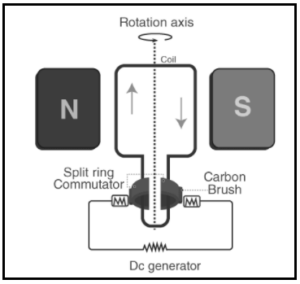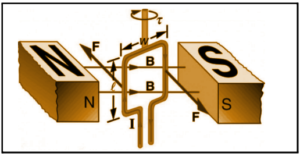Table of Contents
Introduction
Magnetic force on current-carrying wires is most commonly used in motors. In a magnetic field, motors have wire loops. The magnetic field exerts a force on the loops when current is passed through them, which rotates a shaft. In the process, electrical energy is turned into mechanical work.
The direction of current is reversed after the loop’s surface area is aligned with the magnetic field, resulting in a constant torque on the loop. Commutators and brushes are used to reverse the current flow. To keep the motor moving, the commutator is programmed to reverse the current flow at certain points.
There are three contact places to avoid on a simple commutator, as well as dead spots where the loop would have zero resistance. The twisting force that causes rotation is known as torque. A current loop is an electrical system that sends signals to a device using two wires. It can be used to provide electricity or for analogue signalling.
The power supply’s current goes through the wire to the transmitter. The current flow is controlled by the transmitter. The loop current, which is proportional to the measured parameter, is the only current allowed to travel through the transmitter. Through the wire, the current returns to the controller.
The information about torque on current loop from various physics-related articles are available here. Torque on current loop and its general concepts are important topics in physics. Students who want to flourish in physics need to be well known about torque on current loop to get deep knowledge about it to do well on their exams. The general ideologies, and concepts are provided here to assist students in effectively understanding the respective topic. Continue to visit our website for additional physics help.
Overview:
As the dimensions of the source are reduced to zero while the magnetic moment remains constant, a magnetic dipole is the limit of either a closed loop of electric current or a pair of poles. We’ll now prove that a constant current I flowing through a rectangular loop in a uniform magnetic field produces a torque. It is not subjected to a net force. In a homogeneous electric field, its behaviour is identical to that of an electric dipole.
Consider the case of a rectangular loop carrying a current of magnitude I. This loop experiences a torque but no net force when placed in a magnetic field, similar to what an electric dipole experiences in a homogeneous electric field.

Torque on Current Loop:

Consider the situation where the magnetic field B is in the same plane as the rectangular loop. The field has no effect on the arms of the loop that are parallel to the magnets, but it does exert a force F1 on the arms that are perpendicular to the magnets is given by,
F1=IbB
It is directed towards the plane.
In a similar way, we can write the expression for a force F2 which is exerted on the arm CD,
F2=lbB=F1
It can be observed that the total force on the loop is zero and the torque on the loop is,
=F1 a/2+F2 a/2
=IbBa/2+IbBa/2
=I(ab)B
=IAB
ab is considered as the area of the rectangle.
Here, the torque is used to rotate the loop in the anti-clockwise direction.
Consider the case where the loop’s plane is not parallel to the magnetic field. Let be the angle formed by the field and the normal to the coil. We can see that the forces acting on the arms BC and DA will always be equal in size and will always act in opposing directions. Because these forces are equal opposites and collinear at all places, their effects cancel out, resulting in zero-force or torque.
The forces on the arms AB and CD are given by F1 and F2. Such forces are the same in magnitude and opposite in direction and can be given as,
F1=F2=IbB
These two forces will not be collinear and therefore, they act as a couple exerting a torque on the coil.
Now, the magnitude of the torque will be,
τ=F1a/2 sinθ +F2a/2 sinθ
τ=Iab sinθ
τ=ABsinθ
Torque on Current Loop – The Magnetic Moment:
The product of the current flowing in the loop and the area of the rectangular loop can be used to calculate the magnetic moment of a current loop.
That is,
m=IA
The magnitude of A is equal to the area of the rectangular loop, and the direction is determined by the right-hand thumb rule. The torque exerted on a current-carrying coil placed in a magnetic field can be calculated using the vector product of the magnetic moment and the magnetic field, as shown in the previous equation.
Then,
τ=m×B
When pressure is applied to an object, it causes it to move or exert a specific amount of force. For instance, opening a bottle by spinning the cap, removing the lid from a package, opening the doorknob, tying the shoelace, and so on. These are rotational motions, which are torque movements that involve some movement.
There will be no movement if the concept of torque is not understood. Torque is a term that refers to the rotating movement that all objects have, without which we would be unable to use them correctly.
Also read: Important Topic of Physics: Ammeter
Frequently Asked Questions (FAQs):
Question 1: What is the position of the loop when the current is maximum?
Answer: Only when the loop is at the beginning, halfway, and end of the field’s region does the current reach its maximum.
Question 2: Can a torque be balanced by a single force?
Answer: No, because two forces can balance torque. If one force rotates the loop in a clockwise manner, the loop will be rotated in an anticlockwise direction by another force. As a result, no toque will have any effect on the body.
Question 3: How to find the movement of torque on a current loop?
Answer: Torque refers to the concept of allowing items to rotate or move. The formula can be used to determine the movement of the torque. On a current loop, Fleming’s right-hand thumb rule is used to determine the direction of torque. You can find the movement of torque by opening your palms, facing upward, curling your fingers, and sticking out your thumb facing the current. The fingers point to the vector’s area, and by following this method, you can detect magnetic current movements, spirals, rotations, and so on.




